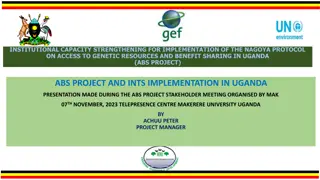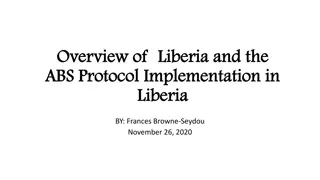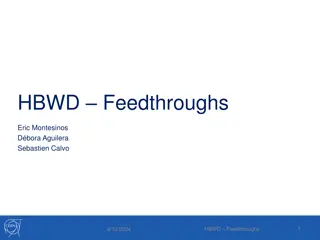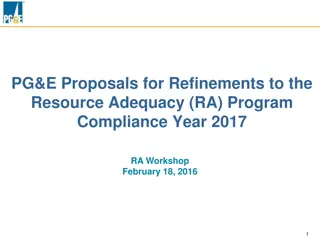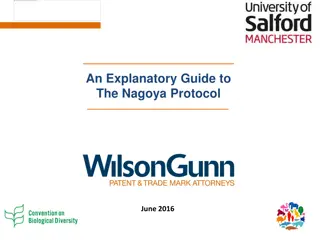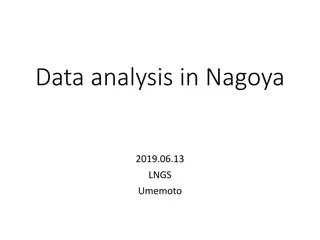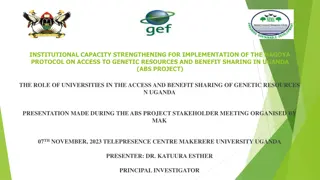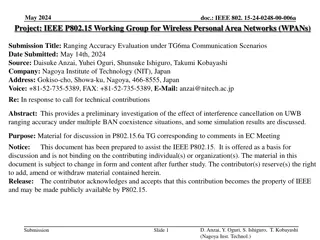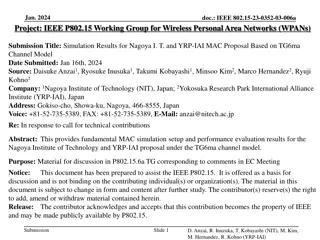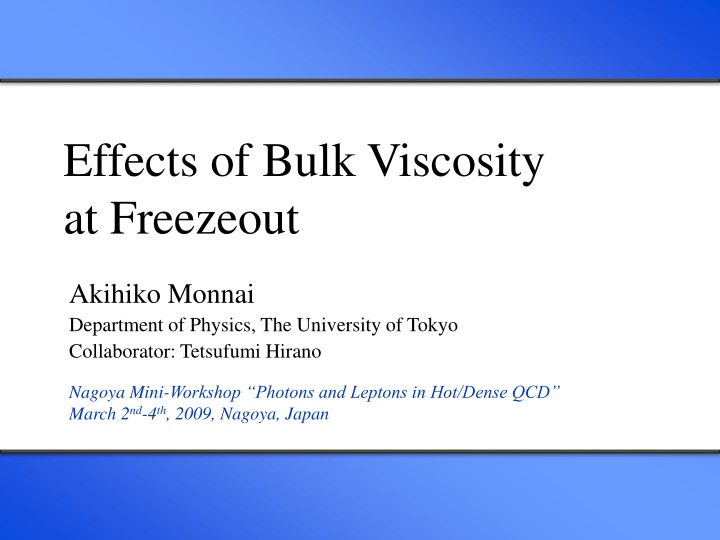
Bulk Viscosity Effects at Freezeout in Hot/Dense QCD Matter
Explore the impact of bulk viscosity at freezeout in hot/dense QCD matter through ideal and viscous hydrodynamics at the Nagoya Mini Workshop. Topics covered include quark-gluon plasma, Cooper-Frye formula, kinetic theory, and numerical results. The study highlights the importance of understanding the hot QCD matter and constraining equations of state and transport coefficients from experimental data.
Uploaded on | 3 Views
Download Presentation

Please find below an Image/Link to download the presentation.
The content on the website is provided AS IS for your information and personal use only. It may not be sold, licensed, or shared on other websites without obtaining consent from the author. If you encounter any issues during the download, it is possible that the publisher has removed the file from their server.
You are allowed to download the files provided on this website for personal or commercial use, subject to the condition that they are used lawfully. All files are the property of their respective owners.
The content on the website is provided AS IS for your information and personal use only. It may not be sold, licensed, or shared on other websites without obtaining consent from the author.
E N D
Presentation Transcript
Effects of Bulk Viscosity at Freezeout Akihiko Monnai Department of Physics, The University of Tokyo Collaborator: Tetsufumi Hirano Nagoya Mini-Workshop Photons and Leptons in Hot/Dense QCD March 2nd-4th, 2009, Nagoya, Japan
Effects of Bulk Viscosity at Freezeout Nagoya Mini Workshop, Nagoya University, March 3rd2009 Outline Introduction - Ideal and viscous hydrodynamics, the Cooper-Frye formula at freezeout Theories and Methods - An overview of the kinetic theory to express the distribution with macroscopic variables Numerical Results - Particle spectra and elliptic flow parameter v2(pT) Summary Outline Introduction (I)
Effects of Bulk Viscosity at Freezeout Nagoya Mini Workshop, Nagoya University, March 3rd2009 Introduction (I) Success of ideal hydrodynamic models for the quark-gluon plasma created in relativistic heavy ion collisions Importance of viscous hydrodynamic models for (1) better understanding of the hot QCD matter (2) constraining the equation of state and the transport coefficients from experimental data The bulk viscosity is expected to become large near the QCD phase transition. Paech & Pratt ( 06) Kharzeev & Tuchin ( 08) Mizutani et al. ( 88) In this work, we see the effects of bulk viscosity at freezeout. Outline Introduction (I) Introduction (II)
Effects of Bulk Viscosity at Freezeout Nagoya Mini Workshop, Nagoya University, March 3rd2009 Introduction (II) Cooper & Frye ( 74) In hydrodynamic analyses, the Cooper-Frye formula is necessary at freezeout: (1) to convert into particles for comparison with experimental data, (2) as an interface from a hydrodynamic model to a cascade model. freezeout hypersurface where, Particles :normal vector to the freezeout hypersurface element :distribution function of the ithparticle :degeneracy d QGP QGP hadron resonance gas Viscous effects are taken into account via (1) variation of the flow (2) modification of the distribution function This needs (3+1)-D viscous hydro. We focus on the contributions of the bulk viscosity to this phenomenon. Introduction (I) Introduction (II) Kinetic Theory (I)
Effects of Bulk Viscosity at Freezeout Nagoya Mini Workshop, Nagoya University, March 3rd2009 Kinetic Theory (I) We express the phase space distribution in terms of macroscopic variables for a multi-component system. Tensor decompositions of the energy-momentum tensor and the net baryon number current: Israel & Stewart ( 79) where , and Bulk pressure: Energy current: Charge current: Shear stress tensor: Introduction (II) Kinetic Theory (I) Kinetic Theory (II)
Effects of Bulk Viscosity at Freezeout Nagoya Mini Workshop, Nagoya University, March 3rd2009 Kinetic Theory (II) Kinetic definitions for a multi-particle system: where giis the degeneracy and biis the baryon number. We need to see viscous corrections at freezeout. We introduce Landau matching conditions to ensure the thermodynamic stability in the 1storder theory. Landau matching conditions: , Together with the kinetic definitions we have 14 equations. Kinetic Theory (I) Kinetic Theory (II) Grad s 14-moment method
Effects of Bulk Viscosity at Freezeout Nagoya Mini Workshop, Nagoya University, March 3rd2009 Grad s 14-moment method Distortion of the distribution function is expressed with 14 (= 4+10) unknowns: where the sign is + for bosons and for fermions. [tensor term ] vs. [scalar term + traceless tensor term ] The trace part The scalar term particle species independent (thermodynamic quantity) particle species dependent (mass dependent) - Equivalent for a single particle system (e.g. pions). - NOT equivalent for a multi-particle system. Kinetic Theory (II) Decomposition of Moments Grad s 14-moment method
Effects of Bulk Viscosity at Freezeout Nagoya Mini Workshop, Nagoya University, March 3rd2009 Decomposition of Moments Definitions: *The former has contributions from both baryons and mesons, while the latter only from baryons. Decomposition of Moments Comments on Quadratic Ansatz Grad s 14-moment method
Effects of Bulk Viscosity at Freezeout Nagoya Mini Workshop, Nagoya University, March 3rd2009 Comments on Quadratic Ansatz Effects of the bulk viscosity on the distribution function was previously considered for a massless gas in QGP with the quadratic ansatz: Dusling & Teaney ( 08) Note (1) This does not satisfy the Landau matching conditions: (2) It is not unique; the bulk viscous term could have been , or . (3) Hydrodynamic simulations need discussion for a resonance gas. We are going to derive the form of the viscous correction without this assumption, for a multi-component gas. Decomposition of Moments Comments on Quadratic Ansatz Prefactors (I)
Effects of Bulk Viscosity at Freezeout Nagoya Mini Workshop, Nagoya University, March 3rd2009 Prefactors (I) Insert the distribution function into the kinetic definitions and the Landau matching conditions: where , , and . They are three independent sets of equations. Comments on Quadratic Ansatz Prefactors (I) Prefactors (II)
Effects of Bulk Viscosity at Freezeout Nagoya Mini Workshop, Nagoya University, March 3rd2009 Prefactors (II) The solutions are where, and are functions of s and s. The explicit form of the deviation can be uniquely determined: with Here, . Prefactors (I) Prefactors (II) Prefactors in Special Case
Effects of Bulk Viscosity at Freezeout Nagoya Mini Workshop, Nagoya University, March 3rd2009 Prefactors in Special Case We consider the Landau frame i.e. and the zero net baryon density limit i.e. , which are often employed for analyses of heavy ion collisions. -Apparently, the matching condition for the baryon number current vanishes. BUT it should be kept because it yields a finite relation even in this limit: Here, ratios of two s remain finite as 0 for and the chemical potential s cancel out. The number of equations does not change in the process. Prefactors Prefactors in Special Case Models (I)
Effects of Bulk Viscosity at Freezeout Nagoya Mini Workshop, Nagoya University, March 3rd2009 Models (I) Equation of State - 16-component hadron resonance gas [mesons and baryons with mass up to (1232)]. 0 is implied. - The models for transport coefficients: Kovtun et al.( 05) Arnold et al.( 06) where (sound velocity) and s is the entropy density. The freezeout temperature: Tf= 0.16(GeV) where and ( ). Prefactors in Special Case Models (I) Models (II)
Effects of Bulk Viscosity at Freezeout Nagoya Mini Workshop, Nagoya University, March 3rd2009 Models (II) Profiles of the flow and the freezeout hypersurface for the calculations of the Cooper-Frye formula were taken from a (3+1)-dimensional ideal hydrodynamic simulation. Hirano et al.( 06) For numerical calculations we take the Landau frame ( ) and the zero net baryon density limit ( ). Models (I) Models (II) Numerical Results (Prefactors)
Effects of Bulk Viscosity at Freezeout Nagoya Mini Workshop, Nagoya University, March 3rd2009 Numerical Results (Prefactors) The prefactors for and near the freezeout temperature Tf: The prefactors of bulk viscosity are generally larger than that of shear viscosity. Contribution of the bulk viscosity to is expected to be large compared with that of the shear viscosity. Models (II) Numerical Results (Prefactors) Numerical Results (Particle Spectra)
Effects of Bulk Viscosity at Freezeout Nagoya Mini Workshop, Nagoya University, March 3rd2009 Numerical Results (Particle Spectra) Au+Au, , b = 7.2(fm), pT -spectra of - Model of the bulk pressure: Parameter is set to and for the results. The bulk viscosity lowers <pT> of the particle spectra. Numerical Results (Prefactors) Numerical Results (Particle Spectra) Numerical Results (v2(pT) )
Effects of Bulk Viscosity at Freezeout Nagoya Mini Workshop, Nagoya University, March 3rd2009 Numerical Results (v2(pT) ) Au+Au, , b = 7.2(fm), v2(pT) of - The bulk viscosity enhances v2(pT) in the high pTregion. *Viscous effects may have been overestimated: (1) No relaxation time for is from the 1st order theory. (2) Derivatives of are larger than those of real viscous flow. Numerical Results (Particle Spectra) Numerical Results (v2(pT) ) Results with Quadratic Ansatz
Effects of Bulk Viscosity at Freezeout Nagoya Mini Workshop, Nagoya University, March 3rd2009 Results with Quadratic Ansatz pT -spectra and v2(pT) of -with , and the same EoS. Numerical Results (v2(pT) ) Results with Quadratic Ansatz Summary
Effects of Bulk Viscosity at Freezeout Nagoya Mini Workshop, Nagoya University, March 3rd2009 Summary & Outlook We determined fi uniquely and consistently for a multi-particle system. - For the 16-component hadron resonance gas, a non-zero trace tensor term is needed. - The matching conditions remain meaningful in zero net baryon density limit. Modification of f due to the bulk viscosity suppresses particle spectra and enhances the elliptic flow parameter v2(pT) in the high pTregion. The viscous effects may have been overestimated because (1) we considered the ideal hydrodynamic flow, and (2) the bulk pressure is estimated with the first order theory. A full (3+1)-dimensional viscous hydrodynamic flow is necessary to see more realistic behavior of pT-spectra and v2(pT). The bulk viscosity may have a visible effect on particle spectra, and should be treated with care to constrain the transport coefficients with better accuracy from experimental data. Results with Quadratic Ansatz Results for Shear Viscosity Summary Results for Shear + Bulk Viscosity
Effects of Bulk Viscosity at Freezeout Nagoya Mini Workshop, Nagoya University, March 3rd2009 Results for Shear Viscosity pT -spectra and v2(pT) of -with , , and the same EoS. Summary Results for Shear Viscosity Results for Shear + Bulk Viscosity
Effects of Bulk Viscosity at Freezeout Nagoya Mini Workshop, Nagoya University, March 3rd2009 Results for Shear + Bulk Viscosity pT -spectra and v2(pT) of -, with , , and the same EoS. Results for Shear Viscosity Results for Shear + Bulk Viscosity
Effects of Bulk Viscosity at Freezeout Nagoya Mini Workshop, Nagoya University, March 3rd2009 Thank You The numerical code for calculations of s, s and the prefactors shown in this presentation will become an open source in near future at http://tkynt2.phys.s.u-tokyo.ac.jp/~monnai/distributions.html Thank You

